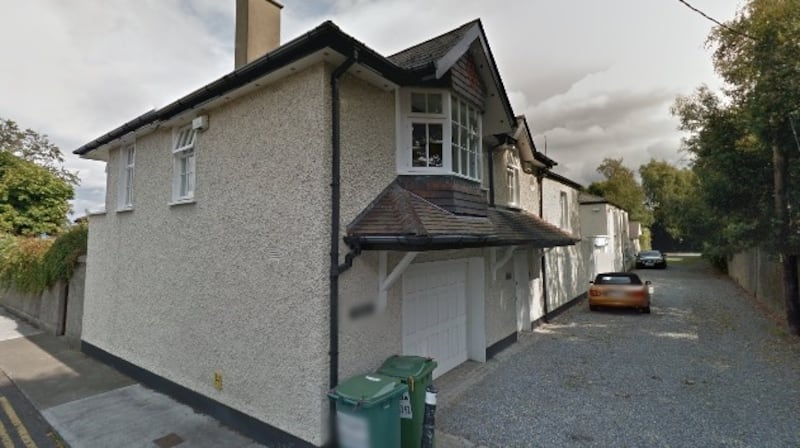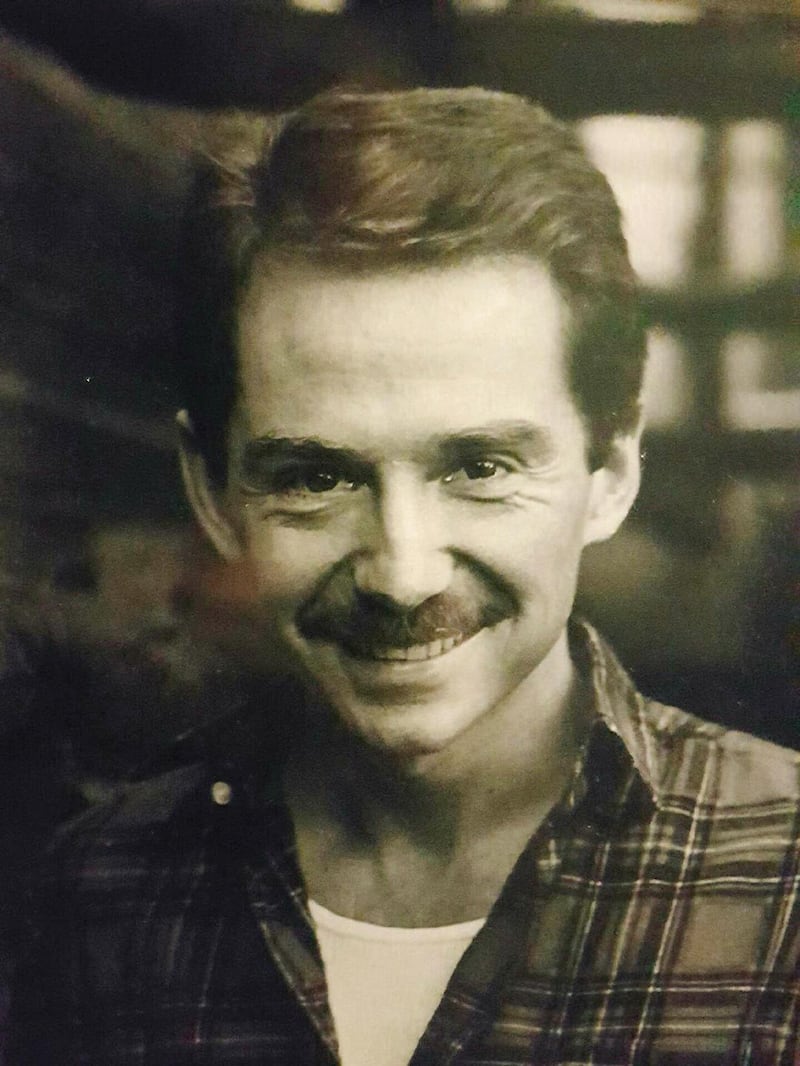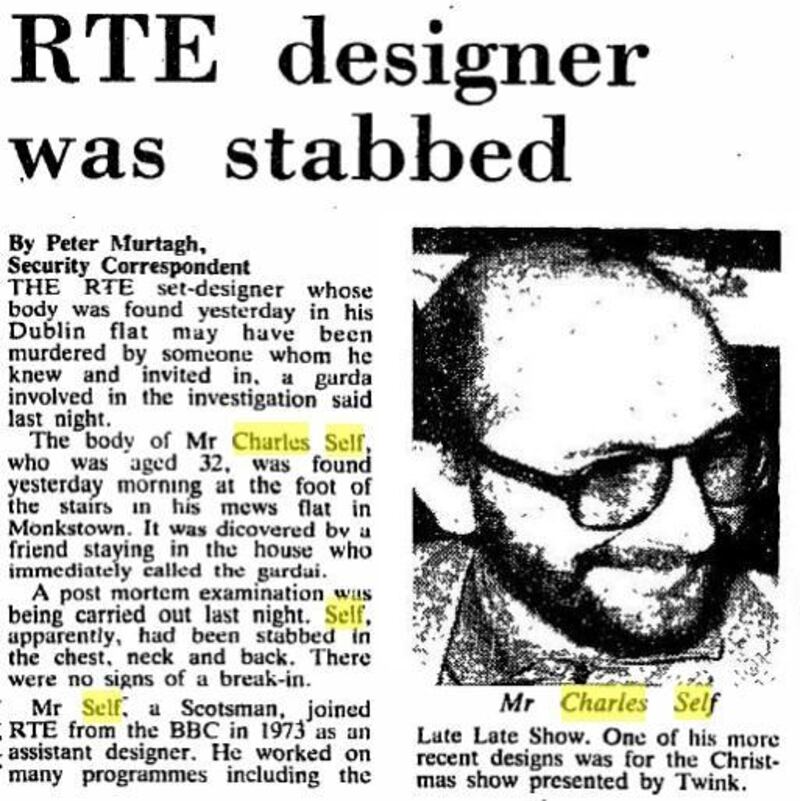“Can you see Crumlin from Howth?” In 1981, Gay Byrne asked Thin Lizzy’s Phil Lynott that rather sarcastic question about the rock star’s move to a posher part of Dublin.
On The Late Late Show, Lynott's glaring cream suit was offset by the most iconic Irish studio set of the time, a backdrop of beige-brown carpet cut in sharp angles. It was the work of Charles Self, a 33-year-old Scottish man employed by RTÉ as a set designer.
Self’s designs, including the set for Twink’s Christmas special in 1981, were admired at RTÉ. On January 20th, 1982, he was in top form, as his creativity was being rewarded with a pay rise and more sets to design.
But that night, Charles Self was stabbed to death at his home in Monkstown, Co Dublin.

Nobody has ever been charged with his killing. Thirty-five years later, those who knew him still grapple with the circumstances of his murder and the controversial investigation that followed.
Charles Self was an avid socialiser and a well-known figure in Dublin’s gay world – at a time when homosexuality was still illegal.
Self’s natural habitat was the Bailey pub on Duke Street off Grafton Street, a spot popular with gay scenesters at the time. He was prone to cashing cheques in the bar, making them out to Brown Thomas. When his bank inquired about his tendency to cash a lot of cheques in pubs, he replied, “They keep better hours than you do.”
The gay scene at the time focused on a few spots in Dublin 2: The Bailey; The Hirschfield Centre in Temple Bar; Rice’s at the corner of South King Street, a pub since demolished as part of the construction of the St Stephen’s Green Shopping Centre; Bartley Dunnes (“A breath of Paris, reminiscent of les Bistros. Cosmopolitan clientele. Left bank mood. Rendezvous of intelligentsia, Bohemian, literati, theatre personalities, socialites, beatniks . . .” ran a print ad for the pub in 1969), which was demolished in 1990 to make way for the Break for the Border bar.
And then there were the cruising spots, parks and public toilets. Burgh Quay was a notable busy spot.
January 1982 lives on in Irish meteorology record books under the category of “exceptional weather events”. Dublin was particularly badly affected. Twenty-six centimetres of snow fell between January 8th and 13th at Dublin Airport, and there were drifts of 1½ metres. The temperature fell below freezing for eight consecutive days. Soldiers were brought in to de-ice Grafton Street, and the Canadian government donated six snowmobiles.
In the depths of that extreme winter, few cars drove, and Brighton Avenue in Monkstown, Co Dublin would have been even quieter than normal. The bottom of the avenue offers an expansive view of the sea, but just before you get to the coast road overlooking the train line (the Dart was not yet complete), Annesley Mews is in a small laneway to the right.
Self lived here, in a house he shared with the RTÉ presenter Vincent Hanley, a friend who was away at the time of Self's death, while he made a new life in London as a DJ.

*****
On the afternoon of Wednesday January 20th, Charles Self was in The Bailey with his friend Bill Maher. They stayed until 2.50pm, when Self went back to work in RTÉ, taking the bus because his car was broken down. The last thing he said to Maher was a joke he cracked when an older man walked past them and said “hello” to the two men. Self poked fun at Maher, saying, “Hmm! I suppose you’ve had him as well!”
Later that day, Self was back in the city centre again. He returned to The Bailey, then went on to Bartley Dunnes. From there, he went to Burgh Quay, the stretch of the Liffey south quays between the Tara Street junction and O’Connell Bridge.
From Burgh Quay, he took a taxi back to Annesley Mews with another man whom the taxi driver described as having fair hair. Self arrived home before 1am. His favourite drink was Black Bush whiskey, and, given the high spirits friends had seen him in that day, he had probably had a few.
Charles Self wasn’t the kind of person to sit in at night. Pubs, receptions, openings, book launches – he was embedded in Dublin’s social scene and knew many in the entertainment business through his work. He was in turn quite well known about town.
He was an avid and intrepid traveller. A friend describes how Charles identified a travel loophole whereby, if you booked the full return fare back from a destination with a particular travel agency, you could stop off multiple times. He used this to the optimum effect when he travelled to Russia and came back through both Prague and Paris. He had been to New York a couple of times, Thailand, and also loved Greece, especially Santorini, a destination he painted pictures of. He often travelled alone.
Charles Self also loved his work – especially his job on the Late Late Show, art and music. “Bubbly, good fun,” is how Maher describes him. In their spare time, “we were out a lot.”
Almost every night when he came home, Self turned on the radio, played music, or watched music videos, and often opened a bottle of wine. He sometimes fell asleep in the chair in the livingroom.
But on the morning of January 21st, shortly before 9am, his body was found at the end of the stairs.
*****
The crime scene itself was one of “absolute chaos” with records strewn across the place, and the murder had been vicious. He had been stabbed 14 times. There was a slash wound to the throat, a piece of a torn ligature around his neck, with the rest tied to a chair.
Some of the stab wounds were “through-and-through”. The weapon – an eight-inch kitchen knife with a white handle – had been wielded with such ferocity it had gone right through his body.
The then state pathologist John Harbison carried out Self’s postmortem, concluding that he had died from stab wounds to the neck and back.
It’s hard to imagine that anyone in the house could have slept through the noise that must have accompanied such violence – a neighbour in a separate property described hearing screaming. But someone did sleep through the night, or most of it.
Berty Tyrer, an Englishman who also worked in RTÉ as a designer, was staying in the house at the time, in a room that had been occupied by Vincent Hanley, who was away.
Tyrer – who found Charles Self’s body on the morning of January 21st – was in his late 60s and may have been hard of hearing. He said he heard no commotion during Self’s violent death, but he was woken by a man who came into Tyrer’s bedroom around 2.30am, saying something like “sorry, wrong room”.
Tyrer made a sketch of this man, a drawing that would become a contentious issue in the case, along with an identikit photograph of a possible suspect.
*****
On the night of January 25th, Self’s body was flown to Glasgow, where the funeral took place. Earlier that day, a service took place at St Andrew’s Presbyterian Church in Blackrock, Co Dublin, with a packed congregation including the then RTÉ director-general George Waters.
A notice carried in The Irish Times from Self's family in Scotland read: "I wish to express my sincere thanks to all his friends and colleagues in Ireland for the kindness shown to the family during a time of much distress. In particular I would like to pay tribute to the help and support given to us by Raidió Teilifís Éireann and the spiritual guidance of the church ministers in attendance."
Det Supt Hubert Reynolds and Det Supt Michael Sullivan led a team of 30 detectives investigating the killing. The initial focus of the investigation was on two rent boys as suspects.
*****
As the investigation got under way, the pursuit of gay men as witnesses or suspects became one of the most controversial aspects of the case, affecting the lives of many people who had no connection to the murder.
By Saturday March 20th, 1982, harassment was being reported from members of the gay community to the Irish Council for Civil Liberties (ICCL). The Irish Times reported, "Homosexuals complain that gardaí have been demanding they agree to be fingerprinted, photographed and give statements."
Many were not openly gay.
“They claim that detectives have repeatedly called to their homes and places of work, causing them considerable embarrassment. Some also claim that family anguish has been caused when they were forced to reveal details of their sex lives to their parents because of the gardaí.”
Kader Asmal of the ICCL said at the time, “Something rather odd is emerging. It appears to me that in certain cases there is a desire to draw up a profile on gays in Dublin.”
Eamon Somers, then president of the National Gay Federation (NFG), said people were worried that information gathered by gardaí could be released to civil servants screening job applicants.
On March 23rd, Peter Murtagh wrote an article in The Irish Times headlined "Gays allege threats and taunts by gardaí". The article included an instance of a man being approached by detectives in the Phoenix Park for questioning.
Another young man spoke of gardaí coming to his home four times, along with several phone calls, and was pressured to come out to his family.
Edmund Lynch, who worked in RTÉ and knew Charles Self, has been conducting interviews in recent years as part of his Irish LGBT History Project. Some of those interviews go over people’s memories of the Self investigation.
Ciaran McKinney told Lynch he “knew Charles vaguely, to say hello to. He used to drink in the Bailey and there were a whole bunch of us who hung out there.”
After Self’s death, McKinney says gardaí showed “no sensitivity, no sense of confidentiality about people’s lives. A bunch of my friends were outed through that process. I know for a fact that a number of people left the country because of that experience.”
In late March, a public meeting was held by the Council for Civil Liberties and the Prisoner’s Rights Organisation, a human rights group that became involved because of the Garda investigation, to discuss the large number of complaints. That meeting was followed up by a protest in early April outside Pearse Street Garda station over harassment, and the failure to publicly issue the pictures.
“If some people are hurt in relation to our inquiries, then I’m sorry, but we must go on,” Det Supt Hubert Reynolds said.
*****
There were two other high-profile killings of gay men in 1982.
On September 8th, John Roche, a 29-year-old hotel porter who worked in the Munster Hotel in Cork, was stabbed in the chest in a homophobic killing.
On September 9th, Declan Flynn, a gay Irish man who worked for Aer Rianta, was attacked and killed in Dublin’s Fairview Park, a known gay meeting point where a number of other homophobic attacks had occurred before Flynn’s death.
In March 1983, after Flynn’s killers were given suspended sentences, protests took place in Dublin – a public expression of anger often seen as the impetus for the Gay Pride movement in Ireland.
While the protests are often directly linked to the lenient sentences of Flynn’s killers, Self’s murder, and the fear and harassment gay men encountered during the investigation, also contributed to this tipping point.
*****
Alan Bailey, now retired, was the detective sergeant in charge of the Garda Serious Crime Review Team. In 2009, he presented a paper to the FBI in Virginia in the US about the Self case, and in particular about what he believes were elements of the crime scene that were staged.
Why is a crime scene staged, Bailey asks. “It’s staged to deflect or impede the investigation or deflect from some suspect or another.”
Self’s body was found at the bottom of the stairs in the mews house. It was close to the front door, making it impossible to open the door. The presumption was the killer escaped through a small kitchen window. However, there was a planter box on the window sill, which in the process of someone climbing out a window would have been disturbed or knocked over.
“It was clear that it was placed on the ground,” Bailey says, “it wasn’t knocked over, there was no spillage whatsoever, it was lifted off the window-sill and placed on the ground.”
Another “big anomaly,” Bailey says, relates to pools of blood at the scene. “There was furniture placed back over them. They weren’t haphazard. It’s physically impossible.”
“The big thing was with Charles Self was the absolute overkill. It would indicate somebody who wasn’t just killing them to rob them.” The wounds that penetrated the body were “no mean achievement”, he says. The kitchen knife Bailey calls “a weapon of opportunity”.
Bailey says gardaí were wrong at the time to seek male prostitutes as suspects, and instead should have been calling for them as witnesses. “The presumption was this rent boy – for want of a better word – had panicked, hadn’t been able to get out because the position of the body at the foot of the stairs, and came through the kitchen window.” Bailey disagrees with this hypothesis. “It was obviously someone else.”
*****
Berty Tyrer died in December 1995 aged 80. The sketch he made after the murder has been in the shadows of the case for many years.
Following Self’s death, there were several calls from gay activists for gardaí to release the sketch and the identikit photo they had. They were never released publicly.
Bill Maher recalls seeing the sketch in a Garda station at the time, and remembers it as a black pen drawing on a sheet of paper. Maher has been told by police many times in the intervening years that they had no sketch.
But in February 2017, gardaí told Maher they did in fact have the sketch, as well as the photo-fit, and were making further enquiries.
Maher’s theory remains that Self met someone while waiting for a taxi home, a person who would have been travelling in the same direction and whom Charles asked in for a drink.
The person sketched by Berty Tyrer did not fit the description of the “fair-haired man” described as having accompanied Self in the taxi home from town. The man Tyrer saw had dark curly hair and what Maher says Tyrer characterised as a “west Brit accent”.

As 1982 rolled on, Self’s murder was overshadowed by the “grotesque, unbelievable, bizarre and unprecedented” series of incidents involving Malcolm Macarthur, who had murdered a 27-year-old nurse, Bridie Gargan, in the Phoenix Park, and, three days later, a farmer, Dónal Dunne, in Edenderry, Co Offaly. Macarthur was subsequently arrested in the home of the Attorney General, Patrick Connolly, in Dalkey, Co Dublin.
Macarthur was known on the gay scene in Dublin, and also to Self. Some friends can’t shake what they say is a similarity between the description of the person Tyrer drew and Macarthur’s likeness.
In October, Macarthur spoke to a tabloid newspaper. While he did admit that he was a regular drinker in Bartley Dunne’s, he claimed he had stopped socialising there around the time Self was killed.
Bill Maher says he was told Charles Self’s killer was in prison. “A reporter told me he was behind bars,” he says. “[The reporter] said he was quoting a Garda source.”
*****
But there are many theories, and there were other men seen that night.
In Bartley Dunnes, Self spoke to a man in his mid- to late 20s who was carrying a duffel bag. On Burgh Quay, he met two men in their late 20s, one who had dark hair and wore a leather jacket.
Then there was a man in or around his late 20s in Brighton Lane in Monkstown, opposite the lane where Annesley Mews is. This man had short brown hair, and was wearing a tweed beige jacket and dark trousers. A neighbour said they saw a fairly tall man in dark clothes jump over a wall at the mews.
The whole thing didn't fit with me. Charles was in great form that day
Today, the laneway where Annesley Mews sits is one of those pleasant south Dublin nooks, hidden away and peaceful.
A woman who answers the door to a property at Annesley Mews, which was added on in the mid-1990s, says she knows little of the events that occurred there in January 35 years ago. “I only know what’s in the papers,” she says.
For Bill Maher those events still feel like yesterday. “The whole thing didn’t fit with me. Charles was in great form that day. He got promoted, he was getting a pay rise, they were going to give him more work.
“He didn’t frequently bring guys back to the house. I lived in the house [for six months], and I could count on one hand the amount of people he brought back for sex.”
And there’s another peculiar and unexplained aspect to the Charles Self story – one that has no apparent connection with the gruesome murder but is yet another “loose end”.
Almost exactly 14 years later, the person who had hired Charles Self for RTÉ, a man named Alpho O’Reilly, left his home in Sandymount. Neither he nor his car have ever been found.
*****
The case may never be solved but it isn't closed. A Garda spokesperson confirms to The Irish Times that Charles Self's murder "remains under investigation".



















